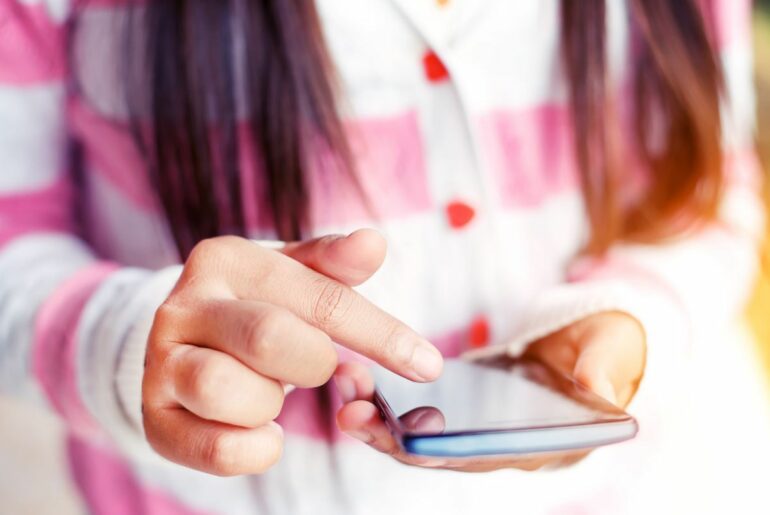It’s a fear so many parents have—finding out your child has shared sexual photos or videos online or with another individual. Unfortunately, it’s incredibly common, with some studies saying as many as 60 percent of teens will send or receive intimate pics, often starting as young as age nine! And teens themselves estimate that about 90 percent of their peers do it, which just shows how “normal” sexting has become for older kids.
The crime of sextortion, or someone (usually an adult) using nudes or sexual images to blackmail someone else (usually a child), is also becoming increasingly common. These criminals, often posing as peers online, manipulate kids into producing illicit material and then threaten to expose them if they don’t send the sextortionist money, passwords, more photos, or something else. They rely on kids’ shame to keep them from asking for help — so having an open dialogue with your child about nudes and online safety can normalize the topic and make it much easier to come to you if they get into a tricky situation.
So whether you have this conversation to prepare your child for potential dangers, catch your kid taking suggestive pictures or video, a racy text pops up while you’re looking at their phone, or they come to you specifically asking for help, the first and most important thing to remember: Be compassionate!
Your child may have made a mistake, and a conversation about online safety is definitely in order… but that’s after you’ve dealt with the situation at hand.
Follow these steps to start the process of having this material removed from the internet:
Reassure your kid.
First and foremost, let your child know that you love them, and you’re going to be right there to help them through this. They’re no doubt already stressed out and scared—particularly if the photos or video were forced or coerced, rather than consensual. Getting angry at them won’t change the past, and it won’t help them learn what to do differently next time. So for now, support and reassure them so they know you’re in their corner by telling them, “Whatever prompted this—I love you, we’ll fix this together.”
It’s also really important to find out more about the situation from your child, particularly how this situation came about. An answer like, “I really like this boy and I’m trying to get him interested in me” will have a very different response from, “My boyfriend told me I had to do this to prove I love him,” or even, “I sent some pictures to someone I met online and he’s threatening to email them to the school if I don’t send more.” At the very least, try and learn:
- If this is something your child wants to do or if they are being pressured or manipulated in some way, etc. and
- What their relationship is to the recipient (eg, friend, significant other, stranger, etc.).
Find the photos.
If the photos were sent to a cooperative individual your child knows, and they haven’t been shared further yet, this process may end up being relatively simple. Just reach out to the person who has the material and ask them to delete it without sharing. If you’re comfortable that this is as far as the problem goes, you can skip the next step, filing reports.
If the photos were shared, stolen, hacked, or sent to someone who is not cooperating (or perhaps even lied about who they are), you’ll need to find out if and how far the materials have spread.
- Do a Google search of your child’s name, including nicknames, to see what comes up.
- If your child still has a copy of the photo, you can do a reverse image search (go to Google Images and click the camera icon in the search bar to “search by image.”
- Search specific social media platforms, though images on private accounts won’t be visible.
Keep in mind that the Google searches will only surface things posted to the open web. If images are being shared in Whatsapp groups, private TikTok accounts, text chains, or things like private gaming servers, even a reverse image search won’t yield any results. Don’t assume that an image not coming up in Google means it’s not being shared.
You might want to repeat this step every few months or so to make sure the images you report are taken down, and that no new ones crop up.
File reports to have photos removed.
Once you’ve figured out where the images are on the internet, you can work on getting them taken down.
- First, take screenshots of the content before filing reports, in case you need them later.
- Screenshot any communication or threats the recipient may have made (they may have told your child they would share the material more widely, threatened to send it to specific family or friends, or tried to blackmail your child into sending more photos or videos).
- Screenshot any reports you file or websites you contact for your records.
- Help your child untag themselves in any online shares, and report the user and post on those sites or platforms.
Then you can contact the platforms to file reports to have the content removed. Each platform has its own reporting process, though they’re all fairly similar and straightforward. You can get instructions for all the major platforms here, from common ones like Facebook to ones you might be less familiar with, like Kik or Discord. And don’t forget to file a Google removal request so that your child’s image won’t show up in search results.
One other option you have for removing the content (if your child took the photo or video of themselves) is filing a DMCA (Digital Millennium Copyright Act) notice with each platform or website, since your child automatically owns the copyright of any photos they’ve taken. You can learn what types of information you need to include and how to find it here. Many sites have terms and conditions for sending them a DMCA notice (try searching the page for “Copyright,” “DMCA,” or “Agent of Notice”), including where to send it. You can also create a DMCA notice yourself if the site doesn’t have a webform you can fill out. If information on where to send it isn’t available, you can find the correct agent to send it to by checking the listing on the U.S. Copyright Office website, or by entering the URL of the website where the image is in a tool that searches for domain owners such as WhoIs or DomainTools.com.
Be aware, however, that the person who shared the images might see the DMCA notice, which will contain personal information such as your name and address. So you might need to pay a fee to have an authorized agent file on your behalf if you want to remain anonymous.
Alternatively, you can report the images and videos to the National Center for Missing and Exploited Children (NCMEC) CyberTipline for help requesting removal of the material and possible referral to support services such as counseling, peer support, and information about legal services. On the plus side, NCMEC is a trusted organization that handled nearly 30 million reports of CSAM (child sexual abuse material, or child pornography) in 2021 alone, so platforms reportedly respond more quickly to trusted, vetted requests from them. However, note that they will make the report available to police for possible investigation.
Determine if you want or need to contact the school and/or law enforcement to report
Legally speaking, any image of a minor that’s sexual (whether they’re nude or not) is CSAM, and it’s illegal to send or receive it. Period. That’s true even if the minor in the image is the one who shares it, and it’s true even if taking and sending/receiving the image was consensual. This is a point you should make clear to your child!
However, parents don’t always need to involve the police. For example, if a minor consensually sends a nude pic to their partner and the partner deletes it, parents might decide to use this as a serious teaching moment and leave it at that.
On the other hand, there are definitely situations where parents should involve law enforcement. Those cases might include (but aren’t limited to) situations where:
- Your child was bribed, forced, or manipulated into creating or sharing the materials
- The other party involved is an adult
- Your child is/was being blackmailed with the materials
- The materials are being widely distributed
Be ready to provide all those screenshots you took of communication with the recipient, posts containing the image, and reports that you filed, and include them in your report to local police. You can also call NCMEC at 1-800-THE-LOST (1-800-843-5678), visit them online, or use their CyberTipline for additional support, and/or call the Cyber Civil Rights Initiative’s crisis hotline at 844-878-CCRI (2274) for help or advice in the U.S. (You can find their resources for international victims here.)
As our kids gain increasing access to the world through their screens, it’s scary to realize how easily others can gain access to our kids. Whether they’ve made a consensual mistake or their vulnerability was taken advantage of, your child might need help processing feelings of shame, anger, betrayal, anxiety, or depression. Be sure your child gets the mental health support they need, and keep the empathy and open communication going at home. Like you told them in the beginning—you can fix this, together.







